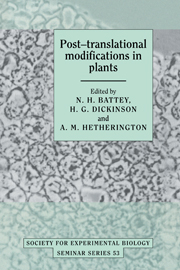Book contents
- Frontmatter
- Contents
- List of contributors
- List of abbreviations
- Preface
- Some roles of post-translational modifications in plants
- Signal transduction and protein phosphorylation in bacteria
- Roles of protein phosphorylation in animal cells
- The significance of post-translational modification of proteins by phosphorylation in the regulation of plant development and metabolism
- Post-translational modification of chloroplast proteins and the regulation of protein turnover
- Purification of a small phosphoprotein from chloroplasts and characterisation of its phosphoryl group
- Use of synthetic peptides to study G proteins and protein kinases within plant cells
- Activation of membrane-associated protein kinase by lipids, its substrates, and its function in signal transduction
- Distribution and function of Ca2+-dependent, calmodulin-independent protein kinases
- Phosphorylation of the plasma membrane proton pump
- The regulation of phosphoenolpyruvate carboxylase by reversible phosphorylation
- Protein phosphorylation and circadian rhythms
- Control of translation by phosphorylation of mRNP proteins in Fucus and Xenopus
- Regulation of plant metabolism by reversible protein (serine/threonine) phosphorylation
- Detection, biosynthesis and some functions of glycans N-linked to plant secreted proteins
- Biosynthesis, intracellular transport and processing of ricin
- Post-translational processing of concanavalin A
- The role of cell surface glycoproteins in differentiation and morphogenesis
- Ubiquitination of proteins during floral development and senescence
- Index
The significance of post-translational modification of proteins by phosphorylation in the regulation of plant development and metabolism
Published online by Cambridge University Press: 06 July 2010
- Frontmatter
- Contents
- List of contributors
- List of abbreviations
- Preface
- Some roles of post-translational modifications in plants
- Signal transduction and protein phosphorylation in bacteria
- Roles of protein phosphorylation in animal cells
- The significance of post-translational modification of proteins by phosphorylation in the regulation of plant development and metabolism
- Post-translational modification of chloroplast proteins and the regulation of protein turnover
- Purification of a small phosphoprotein from chloroplasts and characterisation of its phosphoryl group
- Use of synthetic peptides to study G proteins and protein kinases within plant cells
- Activation of membrane-associated protein kinase by lipids, its substrates, and its function in signal transduction
- Distribution and function of Ca2+-dependent, calmodulin-independent protein kinases
- Phosphorylation of the plasma membrane proton pump
- The regulation of phosphoenolpyruvate carboxylase by reversible phosphorylation
- Protein phosphorylation and circadian rhythms
- Control of translation by phosphorylation of mRNP proteins in Fucus and Xenopus
- Regulation of plant metabolism by reversible protein (serine/threonine) phosphorylation
- Detection, biosynthesis and some functions of glycans N-linked to plant secreted proteins
- Biosynthesis, intracellular transport and processing of ricin
- Post-translational processing of concanavalin A
- The role of cell surface glycoproteins in differentiation and morphogenesis
- Ubiquitination of proteins during floral development and senescence
- Index
Summary
Background
The transfer of intercellular and intracellular information is essential for the control of plant growth and development. In the form of cellular proteins, a framework is present for the reception, amplification and transmission of such information through the plant. The most widely studied mechanism for the transfer of information on this network is phosphorylation. Studies of signal transduction via phosphorylation–dephosphorylation began more than three decades ago in animal cells (Sutherland & Wosilait, 1955), and have reached new intensities in the last decade. As a result, a complex pattern of interacting elements has been identified which, beginning with the receipt of a defined stimulus, results in the modulation of cellular function. In plant cells, where clearly defined agonist–receptor–stimulus models are not so readily available for study, progress has not been so rapid, and investigation has concentrated on finding systems to match those in animals. Significant progress has been achieved, from the identification of a number of plant protein kinases in the early 1970s (Ralph et al., 1972; Keates & Trewavas, 1974), to the identification of several plant GTP-binding proteins (G proteins) (see, for example, Drobak et al., 1988; Blum et al., 1988), and the recent cloning of a calcium-dependent protein kinase (CDPK) (Harper et al., 1991). Progress has been aided by the use of tools developed to elucidate more clearly defined animal pathways, such as anti-G-protein antibodies and specific promoters and inhibitors of phosphorylation.
- Type
- Chapter
- Information
- Post-translational Modifications in Plants , pp. 53 - 64Publisher: Cambridge University PressPrint publication year: 1993
- 3
- Cited by



